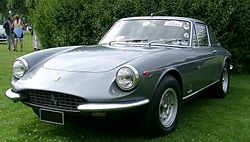Ferrari 365: Difference between revisions
m Reverted edits by 24.159.37.32 (talk) to last version by SmackBot |
365 gtc/4 now separate article |
||
| Line 23: | Line 23: | ||
|production=1968–1970<br>800 produced |
|production=1968–1970<br>800 produced |
||
|predecessor=[[Ferrari 330#330 GT|Ferrari 330 GT 2+2]] |
|predecessor=[[Ferrari 330#330 GT|Ferrari 330 GT 2+2]] |
||
|successor=[[Ferrari |
|successor=[[Ferrari Ferrari 365 GTC/4]] |
||
|body_style=2+2 [[Coupe]] |
|body_style=2+2 [[Coupe]] |
||
}} |
}} |
||
| Line 32: | Line 32: | ||
|production=1968–1970<br>150 produced |
|production=1968–1970<br>150 produced |
||
|predecessor=[[Ferrari 330#330 GTC/GTS|Ferrari 330 GTC]] |
|predecessor=[[Ferrari 330#330 GTC/GTS|Ferrari 330 GTC]] |
||
|successor=[[ |
|successor=[[Ferrari 365 GTC/4]] |
||
|body_style=[[Coupe]] |
|body_style=[[Coupe]] |
||
| layout = [[FR layout]] |
| layout = [[FR layout]] |
||
| Line 53: | Line 53: | ||
}} |
}} |
||
|} |
|} |
||
:''See also [[Ferrari Daytona]] for the 365 GTB/4, GTS/4 |
:''See also [[Ferrari Daytona]] for the 365 GTB/4, GTS/4 and [[Ferrari 365 GTC/4]], GT4 2+2 models'' |
||
The '''Ferrari 365''' is [[Ferrari]]'s large [[FR layout]] [[grand tourer]] and 2+2 line, replacing the [[Ferrari 330|330]] and [[Ferrari America|500 Superfast]] for 1966. Introduced at the [[Geneva Motor Show]], it featured evolutionary styling by [[Pininfarina]]. The famous [[Ferrari Daytona|365 GTB/4 "Daytona"]] with its sharp-creased styling often overshadows this, its more rounded brother. |
The '''Ferrari 365''' is [[Ferrari]]'s large [[FR layout]] [[grand tourer]] and 2+2 line, replacing the [[Ferrari 330|330]] and [[Ferrari America|500 Superfast]] for 1966. Introduced at the [[Geneva Motor Show]], it featured evolutionary styling by [[Pininfarina]]. The famous [[Ferrari Daytona|365 GTB/4 "Daytona"]] with its sharp-creased styling often overshadows this, its more rounded brother. |
||
Revision as of 21:37, 16 February 2010
| ||||||||||||||||||||||||||||||||||||||
| ||||||||||||||||||||||||||||||||||||||
| ||||||||||||||||||||||||||||||||||||||
| ||||||||||||||||||||||||||||||||||||||
| ||||||||||||||||||||||||||||||||||||||
- See also Ferrari Daytona for the 365 GTB/4, GTS/4 and Ferrari 365 GTC/4, GT4 2+2 models
The Ferrari 365 is Ferrari's large FR layout grand tourer and 2+2 line, replacing the 330 and 500 Superfast for 1966. Introduced at the Geneva Motor Show, it featured evolutionary styling by Pininfarina. The famous 365 GTB/4 "Daytona" with its sharp-creased styling often overshadows this, its more rounded brother.
365 California
The 365 California replaced the 500 Superfast for 1966. It was the first 365 model, with its 4.4 L (4390 cc/267 in³) V12 based on the 330's 4.0 L Colombo unit but with an 81 mm bore. The 365 California used the same chassis as the 500 Superfast but with an evolutionary cabriolet body by Pininfarina. Debuting at the Geneva Motor Show in 1966, just 14 examples were produced (including 2 in right hand drive) before production ended in 1967.
On June 28, 2005, a pristine 365 California sold for €736,000 (US$890,000).
365 GT 2+2
The most popular rounded 365 model was 1968's 365 GT 2+2. As the name implies, it was a four-seat coupe, replacing the 330 GT 2+2. Like the car it replaced, the GT 2+2 had an independent suspension in the rear rather than the live axle of the 365 California.
The 365 GT 2+2 was a luxurious car with leather seats, power steering and brakes, electric windows, and optional air conditioning. It quickly became the company's top-selling model with about 800 produced in four years, 52 of which were right hand drive.
365 GTC
The 330 GTC was replaced in 1968 by the 365 GTC. It was essentially just a re-engine of the 330 GTC, with even the styling remaining almost the same. Differences were limited to non-vented front fenders and a vented hood.
Integrating the gearbox with the final drive gave the car a balanced 50:50 weight distribution. The 365 GTC retained the independent rear suspension, employing coil springs and wishbones, of its immediate predecessor, though this was a relatively recent departure for Ferrari. Stopping power came from servo-assisted disc brakes all-round with a split circuit system.[1]
150 examples were built (including 22 in right hand drive) between the 1968 and 1970. It was replaced by the 365 GTC/4.
365 GTS
Like the 330 GTC, the 330 GTS was replaced in 1968 by the 365 GTS. Again a simple re-engine job, this Spider featured the same styling changes as the coupe. Just 20 were built before its place was assumed by the 365 GTB/4-based Daytona Spider.
References
- ^ a b c d e f g h i "Autotest: Ferrari 365 GTC 4,390 c.c. Classic Italian thorough-bred. Superb vee-12 engine, electric performance, light brakes, excellent gearbox. Good ride. Handling better on dry roads than wet. Comfortable two seater, but needs better heating and ventilating system. In its class, a worthy machine". Autocar. 130 (nbr3824): 10–15. 29 May 1969.
{{cite journal}}: Check date values in:|date=(help)


